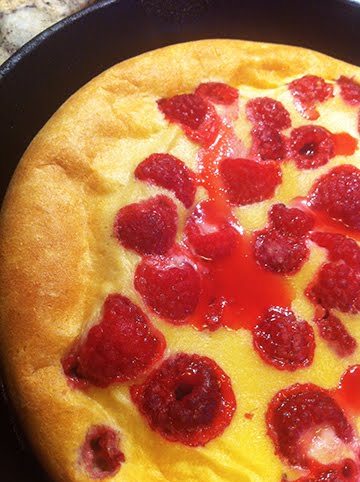
My enthusiasm for writing and posting on this blog has risen and fallen and risen again over the years. I'm in a middle ground sort of place now...happy to blog but finding it harder to find the time. I guess that is not too surprising when you consider that today I have been doing this blog for FOUR YEARS!
To celebrate my four year blogoversery I'm doing my first giveaway ever! All you have to do is comment (c'mon, you know you want to!), making sure that there is another blog or an e-mail address attached to your comment. You can comment on the four years (or any post during that time) or you can comment...and I hope you do...on this post.
What am I giving away? Some goodies from Sur la Table, one of my favorite goodies and gadgets store for cooking and baking. I purchased these...no corporate gifts here, but it is a store I like to browse in and, occasionally, shop in. Here is a photo of what I'll be sending the lucky commenter. Included are a digital timer (which would be very useful for the following recipe), an instant read thermometer (not good for fudge but good for many other temperature measurements), and one of my favorite kitchen implements, a microplane grater, especially great for zesting citrus, but it does a good job on hard cheese and many other foods.

The drawing will be random and I'll contact the winner (and announce who it is...and their blog if they have one) to get their mailing address.
So that takes care of the birthday! What better way to celebrate than to have a guest blogger, especially when that blogger is NoHandle.
In my family the fudge maker was my Dad. Dad had a sweet tooth but was pretty picky about what he ate to appease that sweet tooth. Any kind of fruit pie was usually top of the list. He liked Coca Cola, especially on a hot day. When it came to candy, he liked fudge, especially black walnut fudge.
Maybe fudge making is a Dad kinda thing because it looks like NoHandle, who is also a Dad, makes awesome fudge. If you read this post carefully and follow his suggestions and instructions step by step, you will very likely make awesome fudge, too. If you are a Dad and don't know how to make fudge, it might be a good idea to try this. Your children will go on and on about it for decades if you do...especially if the fudge is good!
Aw, Fudge! , by NoHandle

As you may have seen, if you read the comments on this blog, I have a certain fame (notoriety?) for my fudge making ability. I come by this honestly as Dad loved to do this too. Fudge is easy to do badly, and only somewhat harder to get right. What I want in fudge is a creamy consistency, but not like peanut butter, it should have a bit of crystalline structure to it. I want a great chocolate taste, of course. I don’t tend to add a lot of other flavors; one kind of nut is about as far as I go, and Black Walnuts are a family favorite. Pecans are good too. This is the KISS principle at work. The recipe itself comes from a Hershey’s Cocoa box (Hershey calls it their most difficult), but the devil is in the details. Let me bedevil you.
The ingredients are simple; sugar, cocoa powder, whole milk, butter (not margarine), vanilla extract (again, the real stuff is so much better), and salt. Nuts are optional. I prefer Dutch Process cocoa, but the ordinary kind is OK too. I just got some from Penzey’s, so this will be a bit of an experiment; I usually use Hershey’s. I am talking here about a full batch, but I often just do a half batch. The only cooking change is a smaller pan.
The method is simple, but time and temperature (even more so) are critical. So is cleanliness and moisture control. Keep water away from chocolate when you cook. The first step is to mix the cocoa powder into the sugar, mixing it well enough that the mixture is evenly light brown. There will be extra bits of cocoa powder floating on the top, but that’s OK.

Next, stir in the milk. There will still be renegade chunks of cocoa powder. Now you can turn on the heat to medium.

A few words about equipment are appropriate here as things heat up. The pot needs to be squeaky clean and dry, and larger than you might originally expect. Fudge froths up a lot as it boils, so for a full batch I use a 4 quart sauce pan.

I always use a candy thermometer, but the first time I make fudge in a new situation, I only observe the temperature. I use the candy-maker’s “ball” measure for doneness. I’ll talk about that later in the post. I have mentioned that I live at altitude, and I will tell you that temperature for fudge making is less precise than the ball measure. At sea-level a soft ball is 234 to 240 degrees.
Early on, as the fudge comes to a boil, the froth will rise, then it will fall, losing about half of its extra height. That is the stage when you need to start paying closer attention. Throughout this stage, I recommend stirring occasionally, every few minutes, say five or so. When stirring, be sure the bottom of the pot stays clean or the mixture will burn. Also clean the sides as the froth falls, so that sugar crystals don’t form there. It doesn’t need to be perfectly clean, a thin layer is OK. Clumps are not.
Right about now, the mixture will take on a bubbly satin sheen. You will recognize it when you see it. If you have calibrated your candy thermometer, watch as it approaches the temperature. The last few degrees go very fast.
Now is the time to start testing for doneness. Take a small bowl or teacup of very cold (out of the tap, you don’t need ice cubes unless your tap water is warm) and drip a bit of the fudge mixture into it. It will either pool on the bottom (not ready yet), form a firm ball (when rolled with fingers), and with no “tail” (you’ve gone too far; try adding a half cup of milk and hope for the best), or a soft ball (again when rolled with fingers) and a bit of a tail (Goldilocks time; just right.

Firmer is better than too soft.

Note the temperature for your next attempt, and remove the pot from the heat. I like to put it on a trivet or folded towel so it doesn’t cool too quickly. You can remove the thermometer now if you want, or you can wait until it has cooled. I take it out.
Pour the vanilla extract on top of the fudge, and gently drop the butter on top of that. Do not stir or otherwise disturb the fudge.
 As Alton Brown often says, “Just walk away.” Allow the fudge to rest for about 15-20 minutes, checking on how hot it is during the last 10 minutes or so. I use the “fever method” that is, I place my palm on the side of the pot at the level of the fudge. If it is too hot to keep contact, it’s still too warm. If it is running a mild fever, I may have waited too long, but stirring time will be short (but it may seize up). I am looking for a temperature somewhere around 110 degrees, but I’m not that precise about it. Warmer is safer, but more work.
As Alton Brown often says, “Just walk away.” Allow the fudge to rest for about 15-20 minutes, checking on how hot it is during the last 10 minutes or so. I use the “fever method” that is, I place my palm on the side of the pot at the level of the fudge. If it is too hot to keep contact, it’s still too warm. If it is running a mild fever, I may have waited too long, but stirring time will be short (but it may seize up). I am looking for a temperature somewhere around 110 degrees, but I’m not that precise about it. Warmer is safer, but more work.
While waiting for the fudge to cool, you should put a sheet of aluminum foil on a cookie sheet, and rub a thin layer of butter (salted or sweet, it doesn’t matter) on it, all over. If some stuck to the paper wrapper, use that, and use the end of the rest of the stick, leaving it wrapped. Then sprinkle salt lightly over the butter. Salt really brings out the chocolate flavor. After the salt, add chopped nuts if nuts are part of you plan. Many people mix them into the fudge, but I find that having a layer on the bottom works just as well, and is also easier to stir (well, beat really).
 I guess the next step is obvious, it is also very important. You need to beat the now melted butter into the fudge mixture.
I guess the next step is obvious, it is also very important. You need to beat the now melted butter into the fudge mixture.
There will seem to be a lot of butter at first, but it goes quickly. In addition to distributing the butter, this will add a bit of air to the fudge, and will create that smoothness I mentioned at the start. It may take a while, up to 15 minutes, depending on the temperature when you start, the humidity, and how firm the ball was. Your patience will be rewarded. I use a fresh, long wooden spoon, and just beat as fast as the viscous liquid will permit. As with the boiling, there is a satin texture that develops before it starts to harden, and ribbons form. Watch for it. The whole mass will start to stiffen, and it is time to pour onto the prepared cookie sheet.
 If you stop beating too soon, while it is a thin soup, the texture will suffer, and it will take a while to harden enough to eat. If you wait too long, the fudge will harden in the pot, and you will end up with rough, irregular chunks that look a bit like lava (the stone, not the soap). It will taste OK, but may have more grain to it, and be difficult to extract (use a chisel :-). In the middle, it may start to harden just as you pour. Just use your hands to flatten it on the cookie sheet, cover with wax paper if you like. If your timing is good, it should start to harden within minutes. This is a good time to cut it into pieces. I favor small squares (about three quarters of an inch) but you can go smaller or triangular if you choose.A pizza cutter is the tool of choice.
If you stop beating too soon, while it is a thin soup, the texture will suffer, and it will take a while to harden enough to eat. If you wait too long, the fudge will harden in the pot, and you will end up with rough, irregular chunks that look a bit like lava (the stone, not the soap). It will taste OK, but may have more grain to it, and be difficult to extract (use a chisel :-). In the middle, it may start to harden just as you pour. Just use your hands to flatten it on the cookie sheet, cover with wax paper if you like. If your timing is good, it should start to harden within minutes. This is a good time to cut it into pieces. I favor small squares (about three quarters of an inch) but you can go smaller or triangular if you choose.A pizza cutter is the tool of choice.
There is the possibility that it won’t harden, or stay sticky. This is nature’s way of telling you to have more patience, or use more muscle. It probably didn’t cook long enough. I had this problem early on. The best remedy is to re-heat it and use it as a chocolate sauce, then start over on your fudge journey.
Congratulate yourself, and share and enjoy! Don’t let the fudge clinging to the spoon or pot escape your attention. The crumbs on the cookie sheet are also your immediate reward for a job well done.
Here are the ingredients (available on the Hershey web site too):
3 Cups granulated sugar
.67 Cup cocoa powder
1.5 Cups whole milk
.125 teaspoon salt
1 teaspoon vanilla extract
.25 Cup butter (1/2 stick) at room temperature
.5 Cup chopped nuts
 I've always loved the ocean for as long as I can remember. Both my parents loved the beach even though my Dad wasn't a swimmer and my Mom's fair freckled skin burns easily. When I was little there were many summers when we would pile into the station wagon, my Dad would expertly fit in more luggage and beach paraphernalia than the back of the wagon should have held, and off we would go to the Eastern shore, usually to Rehoboth Beach, Delaware.
I've always loved the ocean for as long as I can remember. Both my parents loved the beach even though my Dad wasn't a swimmer and my Mom's fair freckled skin burns easily. When I was little there were many summers when we would pile into the station wagon, my Dad would expertly fit in more luggage and beach paraphernalia than the back of the wagon should have held, and off we would go to the Eastern shore, usually to Rehoboth Beach, Delaware. Pancetta, which looks sort of like bacon
Pancetta, which looks sort of like bacon We served it up with a nice green salad some some fresh from the oven graham sourdough. I keep making this recipe over and over because I love the taste and it is so easy (if I keep the graham sourdough fed).
We served it up with a nice green salad some some fresh from the oven graham sourdough. I keep making this recipe over and over because I love the taste and it is so easy (if I keep the graham sourdough fed).










































